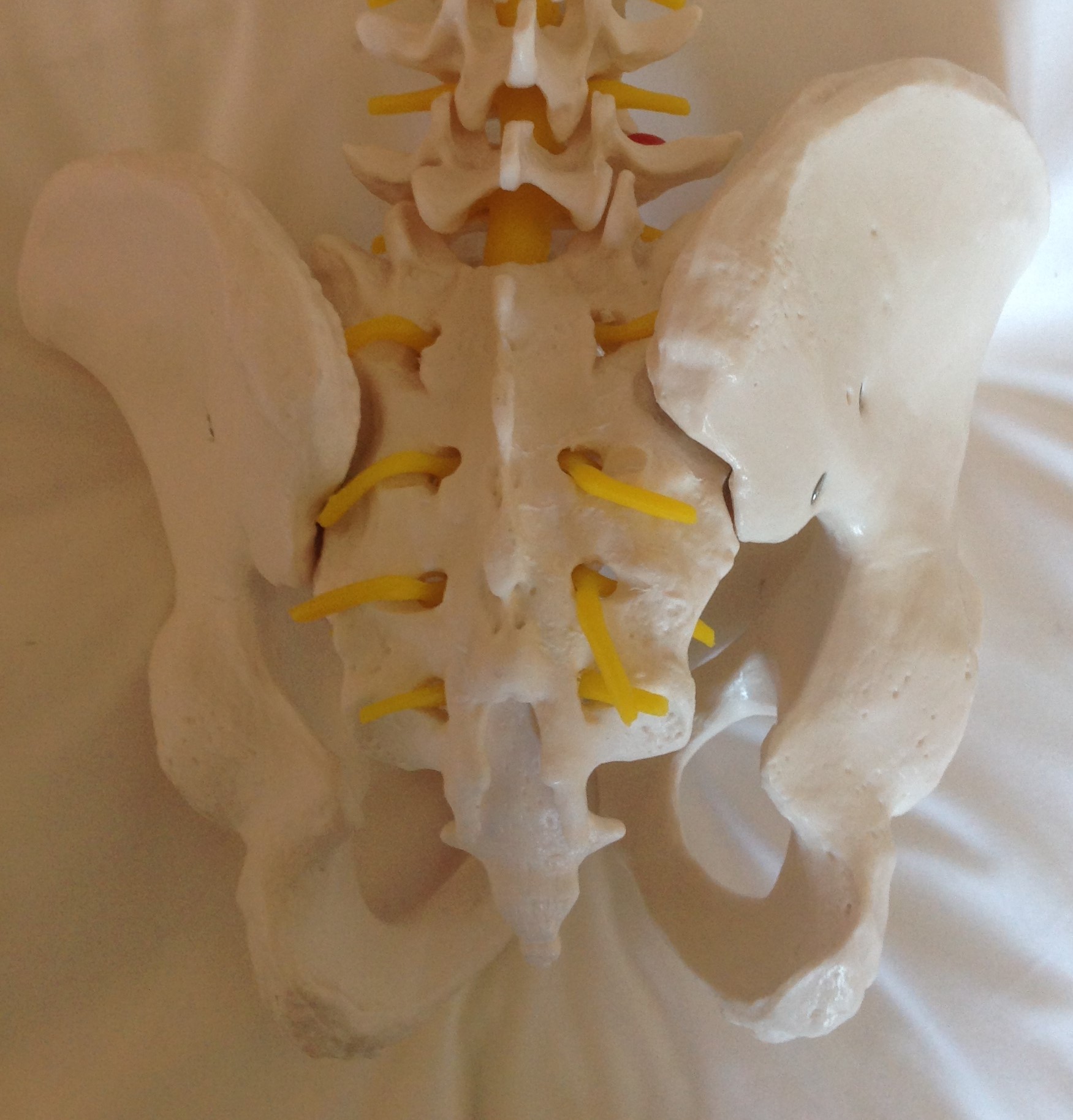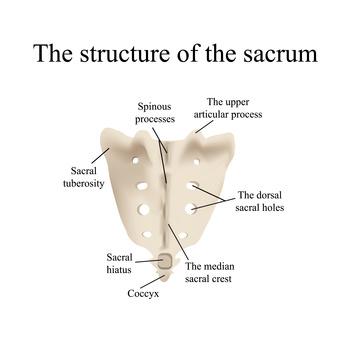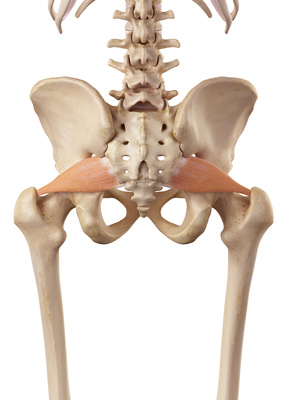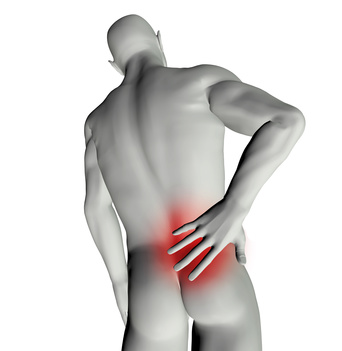 In this blog I thought we might look at a small but important joint in the low back and pelvis that can sometimes be responsible for low back pain, pain in the glutes and irritation of the sciatic nerve.
In this blog I thought we might look at a small but important joint in the low back and pelvis that can sometimes be responsible for low back pain, pain in the glutes and irritation of the sciatic nerve.
It is an extremely challenging area to assess and is one that can too often be missed by clinicians who are attempting to treat low back pain - the joint in question is the sacro-ilac joint. Despite its diminutive size it is a vital joint as it connects the spinal column to the pelvis and transfers load between the upper and lower parts of the body. It is also, as we shall discuss, an area of some controversy amongst physiotherapists and other clinicians.
 Firstly we should have a brief look at some of the anatomy in this area so that we can understand where the joint is, the structures involved and how it might be implicated in low back dysfunction. The sacro-iliac joint is comprised of a joint between two bones - the sacrum and the ilium, it is relatively easy to find on someone and is where some people have obvious dimples either side of the spine, just above where the glute muscles begin.
Firstly we should have a brief look at some of the anatomy in this area so that we can understand where the joint is, the structures involved and how it might be implicated in low back dysfunction. The sacro-iliac joint is comprised of a joint between two bones - the sacrum and the ilium, it is relatively easy to find on someone and is where some people have obvious dimples either side of the spine, just above where the glute muscles begin.
There are two sacro-iliac joints (a left and a right) as the sacrum goes in between the pelvis and ilium. The ilium by the way is the medical name for the upper part of the pelvic girdle. The sacrum is the bone at the end of the lumbar spine and can easily be felt by putting your hand in between your upper buttocks and feeling the bony area there. So in simple terms the sacro-iliac joint is the place where the spine joins and articulates with the pelvis, it links the torso and spine to the pelvis and vice-versa and is therefore a crucial part of the skeletal system. Now before we continue it is worth saying that the sacro-iliac joint (SIJ) is a source of controversy and mystery amongst many physiotherapists and how much movement is present at the joint (if any), how important this movement might be and whether the SIJ is actually a source of pain is all hotly disputed. However this is all beyond the scope of this article and instead I will attempt to give an overview of some ideas about the SIJ and why it might be involved in the pain that some patients experience.
So, firstly can the SIJ be a source of pain? Well there are several studies out there that certainly implicate the SIJ as a source of pain in low back pain and a reasonable estimation from a few studies seems to show that 10 - 20 % of low back pain patients have pain in the SIJ area. So that would mean that for every 100 people with low back pain, there are 10 - 20 of them for whom the SIJ is a source (or at least contributor) of their pain. My own clinical experience would suggest that this figure is rather high, certainly I probably only see 1 or 2 patients a year that have pain that is clearly coming from their SIJ and are clearly positive on the available clinical tests. However I certainly see many more where although the SIJ is possibly not the primary source of pain it definitely contributes to the problems the patient is experiencing and addressing problems at the SIJ improves overall results for the patients. Certainly the SIJ is accepted as a source of pain in women after giving birth (post-partum) and this makes sense as during birth the pelvic girdle is subjected to extreme stresses and hormones such as elastin allow ligaments to stretch beyond their norm - all of which will put a large amount of stress on both of the SIJs and can cause pain.
 So, if we accept that the SIJ can be a source of pain then we now need to look at movement at the SIJ and how that might affect things. This is an area where studies and opinions vary wildly with some showing only minimal movement (approx. 1-2 degs) and others showing much more (up to 17 degrees), whatever the actual number it seems reasonable to suggest that some movement at the joint is important in terms shock absorption and good load transfer between the torso, spine and lower limb. If the joint is not moving as much as it should then this could reasonably be thought to be disturbing normal pelvic girdle and lumbar mechanics and might be a potential source of pain. Movement at the SIJ occurs between the sacrum and innominate (medical name for the whole pelvic bone) with the pelvis moving into eother anterior or posterior rotation and the sacrum either nutating (moving forward) or counter-nutating (moving backward). You might think that this doesn't matter as if the pelvis posteriorly rotates then this is the same as the sacrum nutating but it may be that actually the sacrum has remained static and the pelvis is the part that has moved and in terms of treatment this is an important distinction. Confused?? You are not alone - I did say earlier that it is a confusing area and a subject of much controversy!!
So, if we accept that the SIJ can be a source of pain then we now need to look at movement at the SIJ and how that might affect things. This is an area where studies and opinions vary wildly with some showing only minimal movement (approx. 1-2 degs) and others showing much more (up to 17 degrees), whatever the actual number it seems reasonable to suggest that some movement at the joint is important in terms shock absorption and good load transfer between the torso, spine and lower limb. If the joint is not moving as much as it should then this could reasonably be thought to be disturbing normal pelvic girdle and lumbar mechanics and might be a potential source of pain. Movement at the SIJ occurs between the sacrum and innominate (medical name for the whole pelvic bone) with the pelvis moving into eother anterior or posterior rotation and the sacrum either nutating (moving forward) or counter-nutating (moving backward). You might think that this doesn't matter as if the pelvis posteriorly rotates then this is the same as the sacrum nutating but it may be that actually the sacrum has remained static and the pelvis is the part that has moved and in terms of treatment this is an important distinction. Confused?? You are not alone - I did say earlier that it is a confusing area and a subject of much controversy!!
 Okay, let's just accept that it moves (probably not a huge amount) and that normal movement of the SIJ is important, now we need to think about some reasons why dysfunction of the SIJ might cause pain. Firstly there are the structures in and around the joint itself such as the ligaments which may have been put under more stress and are now inflamed and causing pain. Secondly running from the sacrum to the hip is an important muscle called piriformis, very close to this muscle and in some people actually running through it is the sciatic nerve. If the SIJ is not moving normally then this muscle can become overactive and then cause excess pressure on the sciatic nerve and give the patient pain in the leg. Finally if the SIJ is not moving as it should then it is reasonable to suggest that this may disturb normal lumbar mechanics and create low back pain.
Okay, let's just accept that it moves (probably not a huge amount) and that normal movement of the SIJ is important, now we need to think about some reasons why dysfunction of the SIJ might cause pain. Firstly there are the structures in and around the joint itself such as the ligaments which may have been put under more stress and are now inflamed and causing pain. Secondly running from the sacrum to the hip is an important muscle called piriformis, very close to this muscle and in some people actually running through it is the sciatic nerve. If the SIJ is not moving normally then this muscle can become overactive and then cause excess pressure on the sciatic nerve and give the patient pain in the leg. Finally if the SIJ is not moving as it should then it is reasonable to suggest that this may disturb normal lumbar mechanics and create low back pain.
 At this point most people will be thinking "how do I know if my SIJ is part of the problem?" well certainly I would recommend you see a good physiotherapist for a diagnosis. However if your SIJ is the primary problem (rare) then it is likely that the joint itself will be sore and also often there will be pain in the upper glutes which radiates down the lateral part of the leg.
At this point most people will be thinking "how do I know if my SIJ is part of the problem?" well certainly I would recommend you see a good physiotherapist for a diagnosis. However if your SIJ is the primary problem (rare) then it is likely that the joint itself will be sore and also often there will be pain in the upper glutes which radiates down the lateral part of the leg.
Now this last symptom is a difficult one as problems at L5/S1 will also often cause similar symptoms, differentiating between the two can be challenging.
Okay, I think that is probably enough discussion about the SIJ, hopefully this article has been of some help to you. If you or someone you know is worried that the SIJ may be a source of pain then please get in touch for an assessment by one of our physiotherapists. We are a home visit physiotherapy service based in Lichfield and serving anywhere within a 25 minute drive including areas such as Sutton Coldfield, Burntwood, Cannock, Tamworth, Rugeley and Burton upon Trent. If you would like to book an appointment or would like further information then you can get in touch by phone: 0788 428 1623, email: enquiries@threespiresphysiotherapy.co.ukor by using the contact form.
REQUEST A CALLBACK
Just fill in the form below and give us a quick idea of your problem/request so that we can be better prepared to help you.
